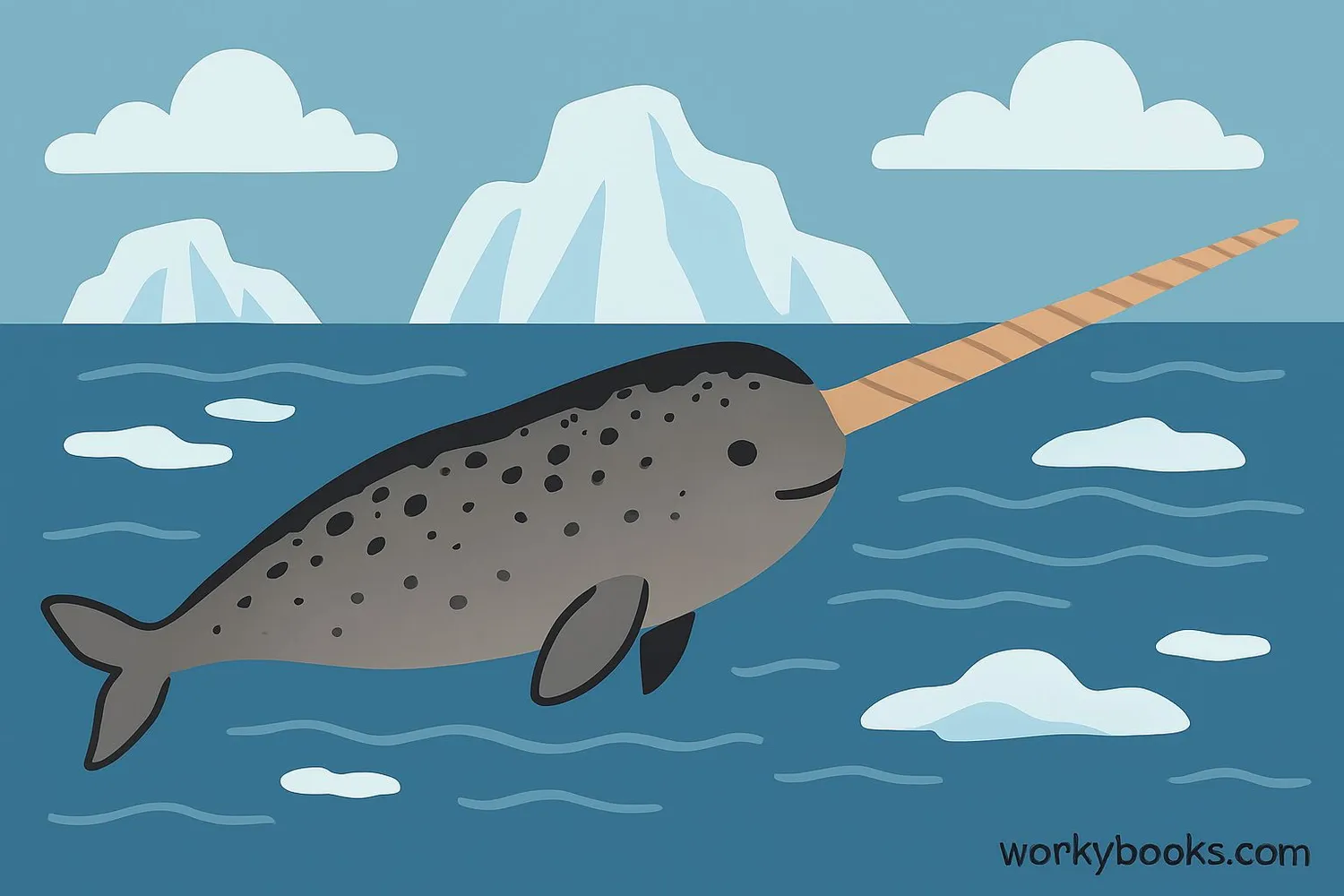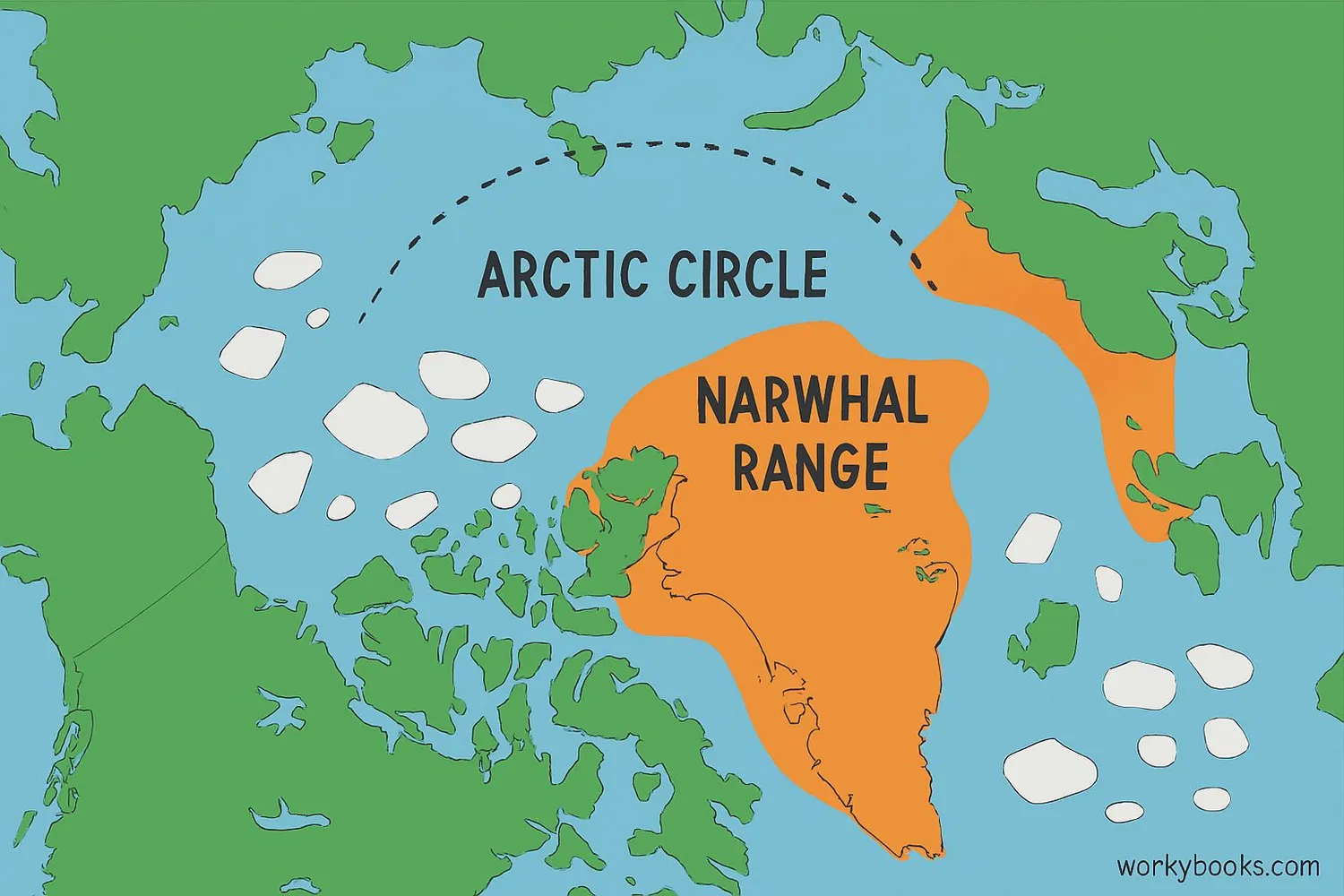Narwhal - Definition, Examples, Quiz, FAQ, Trivia
Discover the amazing whale with a long spiral tusk!
What is a Narwhal?

The narwhal is a special type of whale that lives in the cold Arctic waters. Often called the "unicorn of the sea," this amazing animal has a long, spiral tusk that can grow up to 10 feet long! Narwhals are medium-sized whales, typically 13-18 feet long and weighing 1,760-3,500 pounds. They have mottled gray skin that helps them blend in with the ice and water.
Narwhals belong to the whale family called monodontids, which also includes beluga whales. They're known for their deep dives - they can dive more than a mile deep and stay underwater for 25 minutes! Unlike other whales, narwhals don't have a dorsal fin, which helps them swim under ice.
Narwhal Fact!
Narwhals can live for up to 50 years in the wild. That's longer than most other whales!
The Amazing Tusk

The narwhal's tusk is actually a long tooth! It's one of the most unique features in the animal kingdom. Here's what makes it special:
Tooth Structure
The tusk is actually an overgrown left canine tooth
Spiral Pattern
Grows in a counterclockwise spiral pattern
Size
Can grow up to 10 feet long
Sensory Organ
Contains millions of nerve endings
Gender Difference
Most males have tusks, only 15% of females do
Scientists believe the tusk serves several purposes:
Sensing: The tusk can detect changes in water temperature, pressure, and salinity.
Communication: Narwhals might use their tusks to communicate with each other.
Hunting: Some evidence shows they might use it to stun fish.
The tusk was once highly valued as "unicorn horn" and was more expensive than gold during medieval times!
Habitat & Migration

Narwhals are true Arctic specialists! They live exclusively in the cold waters around the Arctic Circle. Here's where you can find them:
Arctic Waters
Found only in Arctic regions of Canada, Greenland, Norway, and Russia
Ice Environments
Spend most of their time near sea ice and ice floes
Seasonal Migration
Travel from coastal summer areas to offshore winter areas
Narwhals follow a fascinating migration pattern:
• Summer (June-August): Move to coastal areas and fjords with less ice
• Fall (September-November): Migrate south as ice forms
• Winter (December-May): Live in deep offshore waters with heavy ice cover
During winter, narwhals depend on cracks in the ice called "leads" to breathe. They can travel more than 600 miles during their seasonal migrations!
Diet & Behavior

Narwhals are skilled hunters that dive deep to find their food. Here's what they eat and how they behave:
Diet
Mostly fish like Arctic cod, halibut, and squid
Social Groups
Live in groups called pods of 10-100 individuals
Diving Experts
Can dive deeper than 5,000 feet for 25 minutes
Narwhals use echolocation to find food in the dark ocean depths. They make clicking sounds that bounce off objects, helping them "see" with sound. During summer, they often gather in large groups of up to 1,000 narwhals! Scientists have recorded more than 50 different sounds that narwhals use to communicate with each other.
Their main predators are polar bears, orcas, and walruses. Polar bears wait by breathing holes to catch narwhals when they surface for air.
Conservation

Narwhals face several threats in their Arctic home:
Climate Change
Melting sea ice reduces their habitat
Shipping Traffic
Increased Arctic shipping causes noise pollution
Hunting
Some indigenous communities hunt narwhals sustainably
Conservation status:
• IUCN Red List: Near Threatened
• Population estimate: Around 170,000 individuals
Scientists are working to protect narwhals by:
• Monitoring populations through aerial surveys
• Creating protected marine areas
• Regulating Arctic shipping routes
• Working with indigenous communities on sustainable hunting
How You Can Help
Reduce your carbon footprint to help fight climate change and protect the narwhal's Arctic habitat!
Narwhal Quiz
Test your narwhal knowledge with this fun quiz! Answer all 5 questions to see how much you've learned.
Frequently Asked Questions
Here are answers to some common questions about narwhals:
Fun Narwhal Trivia
Discover some amazing facts about narwhals!
Tusked Females
While most males have tusks, about 15% of females grow them too! Female tusks are typically shorter and less spiral-shaped than male tusks.
Unicorn Legend
During the Middle Ages, narwhal tusks were sold as "unicorn horns" and were worth more than their weight in gold! People believed they had magical properties.
Deep Divers
Narwhals make some of the deepest dives of any marine mammal. They routinely dive to depths of 2,600 feet (800 meters), with record dives exceeding 5,000 feet (1,500 meters)!
Vocal Communicators
Narwhals are very vocal animals! Scientists have recorded them making clicks, whistles, and knocks. Each pod has its own distinct "dialect" of sounds.


